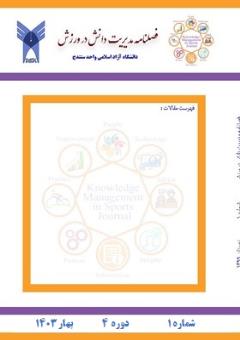شناسایی و اولویتبندی راهبردهای اتمام پروژههای عمرانی ورزشی کشور
محورهای موضوعی : سایر موضوعات مرتبط با مدیریت ورزشی
محمد حسامی
1
,
الهام مشکل گشا
2
*
![]()
1 - گروه تربیت بدنی، واحد مبارکه، دانشگاه آزاد اسلامی، مبارکه، اصفهان، ایران.
2 - گروه تربیت بدنی ، واحد مبارکه، دانشگاه آزاد اسلامی، مبارکه، اصفهان، ایران.
کلید واژه: نظام مدیریت پروژه, راهبردهای توسعه, نظریه داده بنیاد, پروژههای عمرانی ورزشی,
چکیده مقاله :
هدف از این پژوهش شناسایی و اولویتبندی راهبردهای اتمام پروژههای عمرانی ورزشی کشور بود. این پژوهش به لحاظ هدف کاربردی و به لحاظ روش گردآوری در زمرۀ پژوهشهای آمیخته (کیفی- کمی) است. جامعۀ آماری این پژوهش را در بخش کیفی صاحبنظران تشکیل میدادند. جامعه آماری این پژوهش را در بخش کمی کارکنان شرکت توسعه و نگهداری اماکن ورزشی کشور و همچنین مدیران اماکن ورزشی تشکیل میدادند. براساس تعداد پارامترهای موجود در مدل حجم نمونه قسمت کمی برابر با 110 نفر بود و روش نمونهگیری در دسترس بود. ابزار گردآوری اطلاعات مصاحبه و پرسشنامه بود. بهمنظور تجزیه و تحلیل دادهها در بخش کیفی از روش کدگذاری و در بخش کمی از تحلیل عاملی تأییدی و تحلیل سلسله مراتبی استفاده شد. یافتهها نشان داد الگوی نظری با الگوی تجربی سازگار است و از بین راهبردهای توسعه پروژههای عمرانی ورزشی کشور راهبرد تدوین نظام مدیریت پروژه با وزن نسبی 216/0، گسترش نقش و مشارکت بخش خصوصی با وزن نسبی 212/0 و تدوین نظام برنامهریزی پروژهها با وزن نسبی 164/0 مهمترین راهبرد هستند. بهنظر میرسد پروژههای عمرانی ورزشی بهطور خاص شرکت توسعه و نگهداری اماکن ورزشی کشور با در نظر گرفتن این راهبردها در برنامهریزیها و سیاستهای خود بتوانند زمینه کاهش تأخیر در پروژهای عمرانی و در نهایت توسعه ورزش و بهرهمندی از مزایای آن در سطح جامعه فراهم آورند.
The purpose of this research was to identify and prioritize the strategies for completing sports construction projects in the country. This research is in the category of mixed (qualitative-quantitative) research in terms of practical purpose and in terms of collection method. The statistical population of this research was made up of employees of the country's sports facilities development and maintenance company as well as managers of sports facilities. Based on the number of parameters in the model, the sample size of the quantitative part was equal to 110 people and the sampling method was available. The data collection tools were interviews and questionnaires. In order to analyze the data, coding method was used in the qualitative part and confirmatory factor analysis and hierarchical analysis were used in the quantitative part. The findings showed that the theoretical model is compatible with the experimental model, and among the development strategies of sports construction projects in the country, the strategy of developing a project management system with a relative weight of 0.216, expanding the role and participation of the private sector with a relative weight of 0.212, and developing a system Project planning with a relative weight of 0.164 is the most important strategy. It seems that sports construction projects, especially the country's sports facilities development and maintenance company, by considering these strategies in their plans and policies, can reduce the delay in construction projects and finally Develop sports and enjoy its benefits at the community level.

